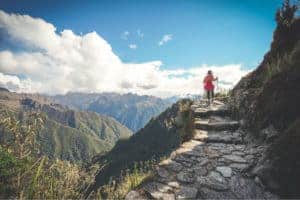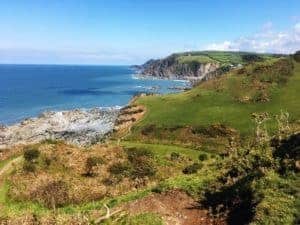A thrilling and rewarding experience is not only seeing Machu Picchu up close in person but also taking several days to trek there. It’s a dream for many and an exciting adventure to embark on. So, once you’ve decided you’re going to trek to Machu Picchu, you’ll have to decide which route to take. The most popular route is the Inca Trail but there’s also the Salkantay Trek. Both have their pros and cons, so which is the better option for you?
Inca Trail Overview
Distance: 45 km or 26 miles
Duration: 4-5 days
Difficulty: Moderate
Highest point: 4215 m
Availability: Government requires every trekker gets a tourist permits in advance (capped at 200 a day) and it’s required to go with a guide.
The Inca Trail is known as one of the best hikes in South America and the and the well-known route to Machu Picchu. You’ll follow the ancient road system built by the Incas as you navigate through dramatic mountain passes, ruins, and misty forests as you dive into the Peruvian countryside. After 4-5 days of moderate hiking you’ll arrive at Machu Picchu through the Sun Gate.

Highlights
Following the Inca Trail, you’ll stumble upon ancient ruins as you trek through the Andes Mountains. The dramatic mountain passes and misty forests will be your backdrop through must of the trek.
At the end of your first day you’ll pass the ruins of Wayllabamba, which translates to “grassy plain” and it’s an excellent spot to catch the sunset.
The second day will involve trekking through the gorgeous and green Valley of Llulluchapampa. Throughout the rest of the journey you’ll see other ruins like Wiñay Wayna and Phuyupatamarca (The City Above the Clouds).
One of the best parts, of course, is the final morning as you trek to see the sunrise at the Sun Gate before finally entering Machu Picchu.
Difficulty
Regular fitness is recommended for any extending hiking, so the same applies when hiking through the Andes to Machu Picchu. The general difficultly of the Inca Trail is moderate, but you are hiking 45 kilometres over typically 4 days. This means you’ll spend roughly 6-9 hours walking each day.
Facilities
As the Inca Trail is the more popular and touristic option, it offers better facilities to trekkers. Toilets are showers are available throughout the trail and are generally well-maintained.
There are campsites throughout the route, and they are designed by the government, so more groups will be sleeping at once place. There are also options for a more “glamping” experience with better bedding and tents.
Pros and Cons for the Inca Trail
The Inca Trail is full of history, which is why most people would choose it. It’s also less strenuous than the Salkantay Trek and takes slightly less time. On the downside, it’s more expensive as you have to go with a guide and Inca Trail tours are typically more expensive than tours on the Salkantay Trek. Of course, it’s a busier trail, so it’ll be slightly more crowded, and you won’t be able to see as much wildlife.
Salkantay Trek Overview
Distance: 60 km or 37 miles
Duration: 5 days
Difficulty: Challenging
Highest point: 4600 m
Availability: No tourist permit restrictions, typically around 50 hikers per day.
The Salkantay Trek is an excellent alternative to the classic route to Machu Picchu. This route offers new views and an exciting trek through the Andes. You’ll pass by the gorgeous Humantay Lagoon and witness the jaw-dropping vista views that the Salkantay Pass offers. The hike will end, of course, once you reach the prize: Machu Picchu. You’ll be able to tour and wander the World Heritage site at your own pace.
Highlights
Following the Salkantay Trek you’ll witness sweeping, mountain landscapes and tropical jungles
as you navigate through the Andes Mountains.
On the first day you’ll trek to the marvelous turquoise-coloured Humantay Lagoon, which is one of the top highlights. On the second day, you’ll make it to the treks highest point: the Salkantay Pass, which offers stunning vistas of the valley below.
Other highlights include seeing the Mount Salkantay, one of the most iconic mountains in the Cusco region as well as waterfalls, natural wildlife, and the cloud forest.
Finally, you’ll hike along the Apu Salkantay and reap the reward of finally arriving at Machu Picchu.
Difficulty
Given the additional kilometres of this hike, it’s more strenuous than the Inca Trail and requires good physical fitness. You’ll trek through rougher, deeper, and higher terrain over the course of 5 days. You’ll trek around 6-7 hours each day and a 3 hour stretch the last day from Santa Teresa to Machu Picchu Pueblo.
Facilities
There are toilets available throughout the treks. They aren’t glamorous but they do exist as well as cold and hot showers. As for the campsites, you can stay in tents and some private tour operators have their own private campsites with more comfortable tents and bedding and plus privacy with toilets and showers. If you’re looking for a finer glamping experience, there are also upscale lodges available.
Pros and Cons for the Salkantay Trail
The Salkantay Trail is more strenuous and takes slightly longer than the Inca Trail. However, since it’s not as common, you’ll feel more secluded and gives you a better chance at checking out Peruvian wildlife. On the downside, there’s less history to this trail, which turns some trekkers away.


